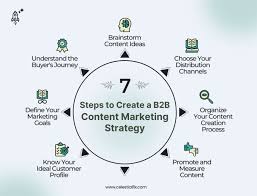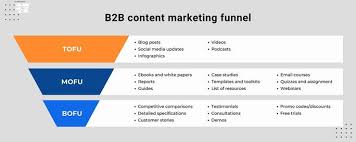In a world where 71% of B2B buyers rely on blog content during their purchase journey, a robust content marketing strategy isn’t just an option—it’s necessary. This comprehensive playbook will transform your B2B content marketing from a cost center into a revenue engine.
🎯 Part 1: Foundation Building
Understanding Your B2B Ecosystem
Buyer Persona Development Matrix
| Component | Questions to Answer | Action Items |
| Demographics | Who are your ideal customers? | Create detailed company profiles |
| Pain Points | What keeps them up at night? | Conduct customer interviews |
| Goals | What does success look like? | Map solutions to objectives |
| Decision Journey | How do they buy? | Document buying stages |
Power Tip: Create a “Day in the Life” document for each key decision-maker to understand their challenges and information needs truly.
🚀 Part 2: Strategic Planning
Goal-Setting Framework
- Revenue Impact
- Target: Increase marketing-qualified leads by 40% in 6 months
- Measurement: Track lead source attribution
- Budget allocation: 60% content creation, 40% distribution
- Brand Authority
- Target: Achieve thought leadership in 2-3 specific niches
- Measurement: Share of voice, media mentions, speaking opportunities
- Timeline: Quarterly milestones
📊 Part 3: Content Architecture
The B2B Content Matrix
| Stage | Content Type | Purpose | Success Metrics |
| Awareness | • Trend Reports • Industry Studies • Thought Leadership Articles | Establish expertise | Content-Type |
| Consideration | • Comparison Guides • ROI Calculators •Implementation Guides | Demonstrate value | Lead magnet downloads |
| Decision | • Case Studies • Product Demos • Implementation Roadmaps | Drive conversion | Demo requests Sales opportunities |

Content Calendar Template (Monthly)
Week 1-2: Core Content Creation
- 2x in-depth blog posts
- 1x gated content piece
- 4x social proof pieces
Week 3-4: Distribution & Engagement
- Email newsletter
- LinkedIn campaign
- Industry forum engagement
- Partner co-marketing
💡 Part 4: Advanced Tactics
Content Amplification Strategies
- Employee Advocacy Program
- Tool recommendations
- Content sharing guidelines
- Engagement incentives
- Account-Based Marketing Integration
- Target account content mapping
- Personalization frameworks
- Multi-channel coordination
Performance Optimization Loop
- Monitor key metrics monthly
- A/B test headlines and formats
- Update existing content quarterly
- Retire underperforming assets
📈 Part 5: Measuring Success
KPI Dashboard Elements
- Content engagement rates
- Lead quality scores
- Sales pipeline influence
- Customer feedback metrics
- ROI calculation framework
🔄 Implementation Roadmap
30-Day Quick Start
- Audit existing content
- Define primary personas
- Create initial content calendar
- Set up tracking systems
90-Day Acceleration
- Develop cornerstone content
- Launch distribution system
- Begin testing and optimization
- Measure initial results
Expert Tips & Common Pitfalls
Do’s:
- Focus on quality over quantity
- Build a content optimization process
- Invest in distribution strategies
- Measure impact on revenue
Don’ts:
- Create content without strategy
- Ignore sales team input
- Skip content audits
- Neglect mobile optimization
Additional Resources
- Content audit template
- Editorial calendar template
- Distribution checklist
- ROI calculator
Remember: The most successful B2B content marketing strategies consistently deliver value while maintaining agility to adapt to market changes.
FAQs
1. What’s the Optimal Content Mix for B2B Marketing?
- 40% Long-form educational content
- 25% Case studies and social proof
- 20% Technical documentation
- 15% Thought leadership Key Insight: Consistency across formats is crucial
2. How Much Should We Invest in Content Marketing?
Investment Benchmarks:
- Early-stage companies: 15-20% of marketing budget
- Growth-stage companies: 25-30% of marketing budget
- Enterprise-level: 30-35% of marketing budget
Proven ROI: Content marketing delivers 3x the ROI of paid advertising
3. What Content Formats Drive the Most B2B Leads?
Top Performing Formats in 2024:
- Webinars: 32% conversion rate
- White papers: 25% conversion rate
- Case studies: 21% conversion rate
- Interactive tools: 18% conversion rate
4. What’s the Typical B2B Buying Journey?
Journey Characteristics:
- Average decision cycle: 6-8 months
- Stakeholders involved: 6-10 decision-makers
- 83% of journey completed before sales contact
- 47% of buyers view 3-5 content pieces before engagement
- Average deal size increasing: 27% year-over-year
5. What Are the Key Content Consumption Trends?
Digital Content Consumption Stats:
- 73% of B2B content consumed on mobile devices
- Video content drives 157% more organic traffic
- Interactive content generates 2x more conversions
- 89% of B2B buyers cite ROI calculations as crucial
6. How Effective is B2B Content Marketing?
Performance Metrics:
- 327% higher ROI compared to traditional advertising
- B2B companies with blogs generate 67% more leads
- Content marketing costs 62% less than traditional marketing
- Personalized content drives 3x higher engagement
7. What’s the Impact of AI on B2B Content Marketing?
AI Content Marketing Insights:
- Projected B2B advertising spend: $70 billion by 2026
- AI-powered content recommendations can increase accuracy by 89%
- 72% of B2B buyers prefer content-driven research over sales calls
8. What’s the Recommended Content Creation Strategy?
Microsoft’s B2B Content Framework:
- 80/20 Rule: 80% educational, 20% promotional
- Pillar content length: 2,500+ words
- Content update frequency: Every 90 days
- Format mix: 40% text, 30% video, 30% interactive
9. How Long Does It Take to See Content Marketing Results?
Timeline Expectations:
- Average time to significant ROI: 6-12 months
- 67% of buyers start with general business problem searches
- 73% prefer video content for initial research
- 82% engage with thought leadership content
10. What Are the Key Success Factors?
Strategic Priorities:
- Define clear Ideal Customer Profile (ICP)
- Develop multi-level buyer personas
- Map content to buyer’s journey
- Invest in personalization
- Continuously analyze and optimize content strategy

Leave a Reply